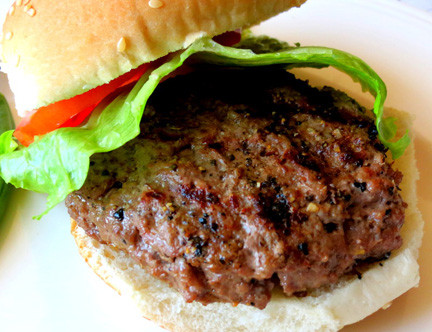Who’s in the kitchen Hamburger today is a lot more than ‘hockfleish’
Growing up in Brooklyn, I don’t remember ever having a barbecue. We ate “hockfleish,” which was basically a hamburger, pan fried.
It was thick and juicy and we ate it without a bun … at least that’s how I remember it. I could be wrong; I’ll let you know after my sister reads the column. She has a much better memory than I do. I do remember my mom soaking challah (crust removed) in water, squeezing out the excess water and mixing it into the mixture. My mom said it made it “shvamik” (soft and fluffy). When the first glatt kosher hamburger joint, Kosher King, opened up in Coney Island, I remember looking at the burger and doing my Clara Peller imitation, “Where’s the beef?” Actually, she might have imitated me, as it was years later that she appeared in the Wendy’s commercial.
Hard to believe, but my husband has no far-fetched funny stories about burgers, so I’ll go with the history of the burger…
The exact origin of the hamburger as we in America know it, is unknown. Most historians believe that it was invented by a cook who placed a Hamburg steak between two slices of bread.
Most claims made by the potential inventors of the hamburger occurred between 1885 and 1904, and was food associated with major events such as amusement parks, fairs and festivals.
One of the possible fathers of the hamburger is Charlie Nagreen (1870–1951) of Seymour, Wisconsin, who, at the age of 15, sold Hamburg steaks from a street stall at the annual Outagamie County Fair.
Americans like to think that they were the first to combine two slices of bread and ground beef into a “hamburger sandwich.” Part of the controversy over the origin of the hamburger is because bread and beef were prepared and eaten separately for many years all over the world, before their combination.
Europeans like to think that the hamburger was created first in their countries.
In the 12th century, the nomadic Mongols carried meat, by horse or camel, on their journeys. The cavalry-dominated army was fast moving and sometimes unable to stop for a meal, so they were often forced to eat while riding. They would place a few pieces of meat under their saddles so that it would crumble with the constant jogging and be cooked by the heat from the animal.
Chopped meat (or minced as they called it back then) was a rare delicacy and meat itself was an ingredient restricted to the higher classes. Russian ships brought recipes for steak tartare to the Port of Hamburg during the 17th century. During the period of the European colonization of the Americas, many immigrants became a kind of “bridge” between the old European recipes and the future development of the hamburger in the United States.
During the first half of the 19th century, Hamburg established itself as one of the largest transatlantic ports in Europe as it became a hub for both passenger and freight shipping. Europeans began their voyages to the United States from Hamburg, introducing their culinary customs to their host country. New York City was the most common destination for ships traveling from Hamburg and various restaurants in the city began offering the Hamburg-style steak to attract German sailors. In the late 19th century, the Hamburg steak became popular on the menus of many restaurants in New York. The oldest document that refers to the Hamburg steak is a Delmonico’s Restaurant menu from 1873, which offered customers an 11 cent plate of Hamburg steak that had been developed by an American chef.
During the following one hundred years, the hamburger spread throughout the world. As a result, a new business model was born--the franchise.
The burger was born in a time when people needed to eat both fast and cheap, at the beginning of the Great Depression of 1929. This environment was favorable for fostering inexpensive food, which was one reason why five-cent hamburgers were so popular.
“Walt” Anderson opened a hamburger stand in Wichita that used hygienic cooking methods, and impressed his Wichita customers so much that many would become regular patrons.
In 1926, Edgar Waldo “Billy” Ingram collaborated with Anderson to open the first White Castle restaurant. The restaurant was founded on the idea of cooking a hamburger quickly, giving it the honor of being the first fast food restaurant.
Bet most of you don’t know the origin of the name. Seems “White” was chosen to escape the public perception that hamburgers were unsanitary, and “Castle” to evoke a higher-class product.
Burgers may be fast food, but they’re also a craft. While researching the history of the hamburger, I found there are 20 clubs devoted to the cult of the perfect hamburger patty, and endless articles devoted to the best burgers you must “try before you die”...if they don’t finish you off first!
Grilled Mouthwatering Burgers
Ingredients:
•3 lbs ground beef
•2 eggs
•1-1/2 tsps salt
•1-1/2 tsps ground black pepper
•1-1/2 C bread crumbs (I use Jason flavored bread crumbs)
•2 tbsp Worcestershire sauce (vegetarian)
•2 onions chopped and sautéed till clear then blended with emersion blender till smooth
Directions:
1.Preheat your grill to high.
2.In a bowl, combine all of the ingredients until evenly incorporated. Form into 8 equal sized burgers.
3.Place the burgers on the hot grill and cook for 4 to 6 minutes on each side, depending on how well done you like them. (Keep in mind that it’s recommended not to prepare rare in the middle.)
Judy Joszef is a pastry and personal chef as well as a party planner. She spent 18 years as a pastry chef at Abigael’s, The Cedar Club, Centro and T42 in the Five Towns, before launching her current business, Soiree. She can be reached at judy.soiree@gmail.com

 56.0°,
Overcast
56.0°,
Overcast 







